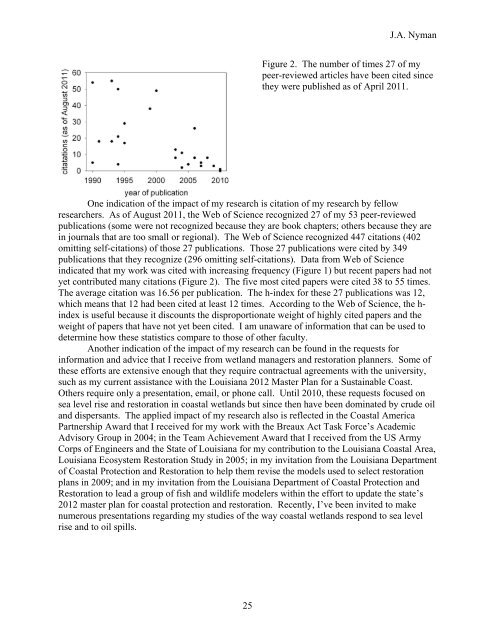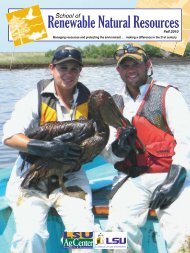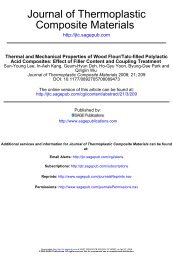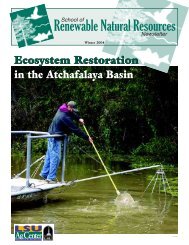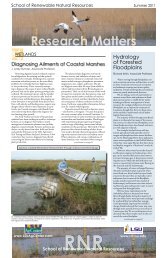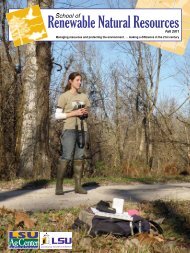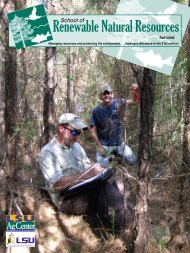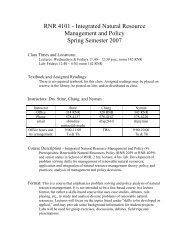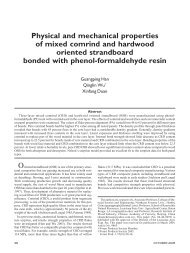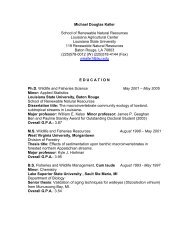john andrew nyman - LSU School of Renewable Natural Resources ...
john andrew nyman - LSU School of Renewable Natural Resources ...
john andrew nyman - LSU School of Renewable Natural Resources ...
You also want an ePaper? Increase the reach of your titles
YUMPU automatically turns print PDFs into web optimized ePapers that Google loves.
J.A. Nyman<br />
Figure 2. The number <strong>of</strong> times 27 <strong>of</strong> my<br />
peer-reviewed articles have been cited since<br />
they were published as <strong>of</strong> April 2011.<br />
One indication <strong>of</strong> the impact <strong>of</strong> my research is citation <strong>of</strong> my research by fellow<br />
researchers. As <strong>of</strong> August 2011, the Web <strong>of</strong> Science recognized 27 <strong>of</strong> my 53 peer-reviewed<br />
publications (some were not recognized because they are book chapters; others because they are<br />
in journals that are too small or regional). The Web <strong>of</strong> Science recognized 447 citations (402<br />
omitting self-citations) <strong>of</strong> those 27 publications. Those 27 publications were cited by 349<br />
publications that they recognize (296 omitting self-citations). Data from Web <strong>of</strong> Science<br />
indicated that my work was cited with increasing frequency (Figure 1) but recent papers had not<br />
yet contributed many citations (Figure 2). The five most cited papers were cited 38 to 55 times.<br />
The average citation was 16.56 per publication. The h-index for these 27 publications was 12,<br />
which means that 12 had been cited at least 12 times. According to the Web <strong>of</strong> Science, the h-<br />
index is useful because it discounts the disproportionate weight <strong>of</strong> highly cited papers and the<br />
weight <strong>of</strong> papers that have not yet been cited. I am unaware <strong>of</strong> information that can be used to<br />
determine how these statistics compare to those <strong>of</strong> other faculty.<br />
Another indication <strong>of</strong> the impact <strong>of</strong> my research can be found in the requests for<br />
information and advice that I receive from wetland managers and restoration planners. Some <strong>of</strong><br />
these efforts are extensive enough that they require contractual agreements with the university,<br />
such as my current assistance with the Louisiana 2012 Master Plan for a Sustainable Coast.<br />
Others require only a presentation, email, or phone call. Until 2010, these requests focused on<br />
sea level rise and restoration in coastal wetlands but since then have been dominated by crude oil<br />
and dispersants. The applied impact <strong>of</strong> my research also is reflected in the Coastal America<br />
Partnership Award that I received for my work with the Breaux Act Task Force’s Academic<br />
Advisory Group in 2004; in the Team Achievement Award that I received from the US Army<br />
Corps <strong>of</strong> Engineers and the State <strong>of</strong> Louisiana for my contribution to the Louisiana Coastal Area,<br />
Louisiana Ecosystem Restoration Study in 2005; in my invitation from the Louisiana Department<br />
<strong>of</strong> Coastal Protection and Restoration to help them revise the models used to select restoration<br />
plans in 2009; and in my invitation from the Louisiana Department <strong>of</strong> Coastal Protection and<br />
Restoration to lead a group <strong>of</strong> fish and wildlife modelers within the effort to update the state’s<br />
2012 master plan for coastal protection and restoration. Recently, I’ve been invited to make<br />
numerous presentations regarding my studies <strong>of</strong> the way coastal wetlands respond to sea level<br />
rise and to oil spills.<br />
25


